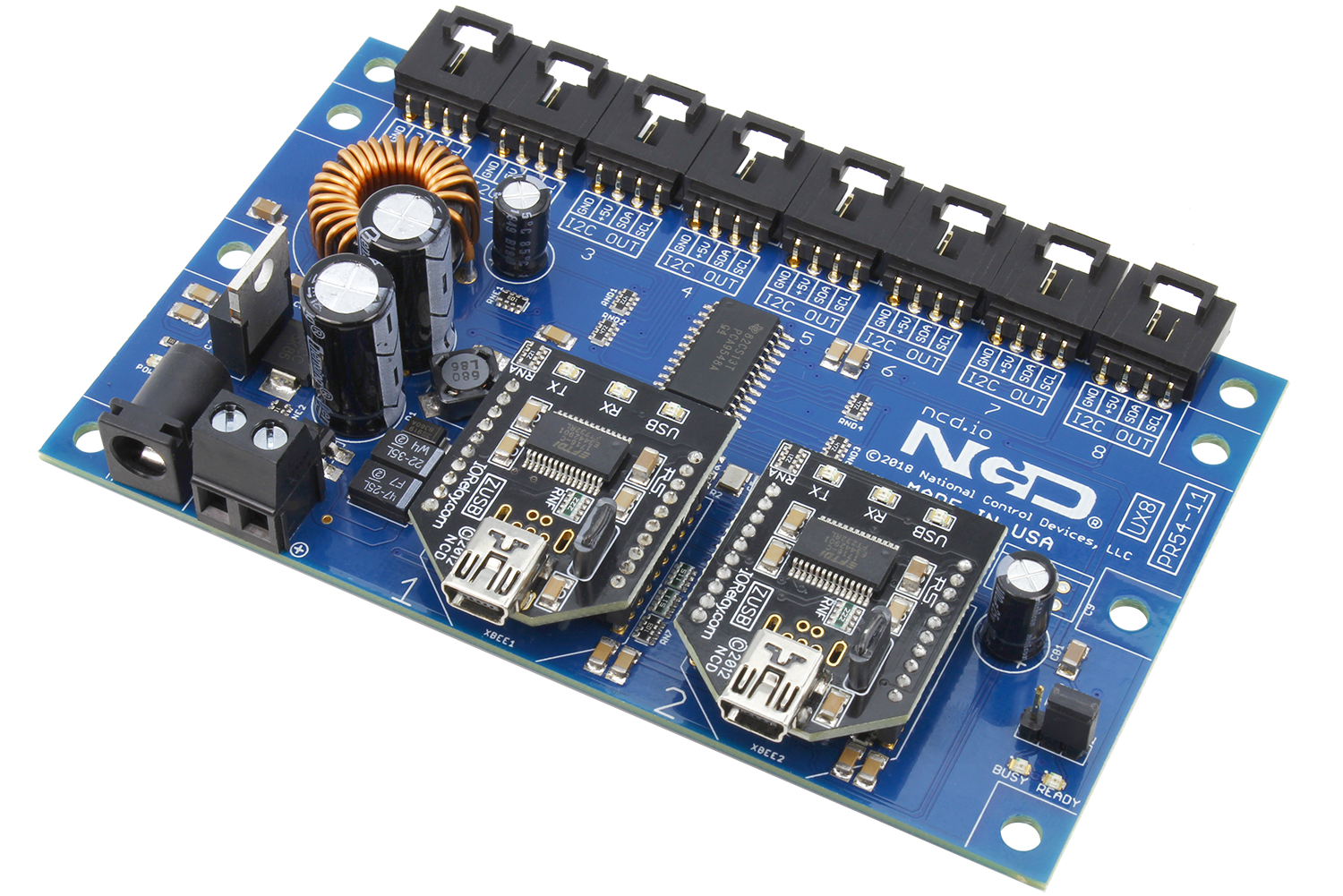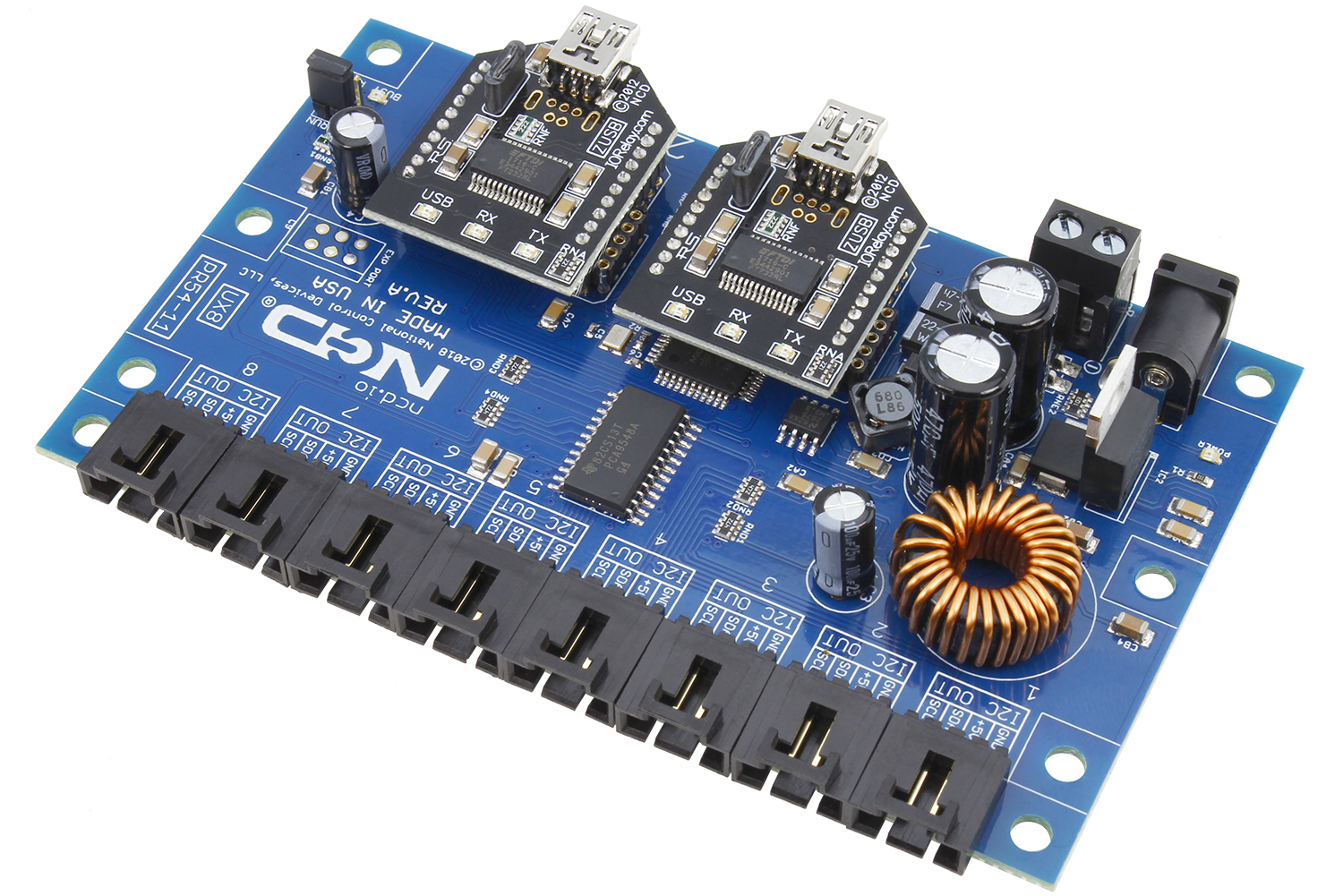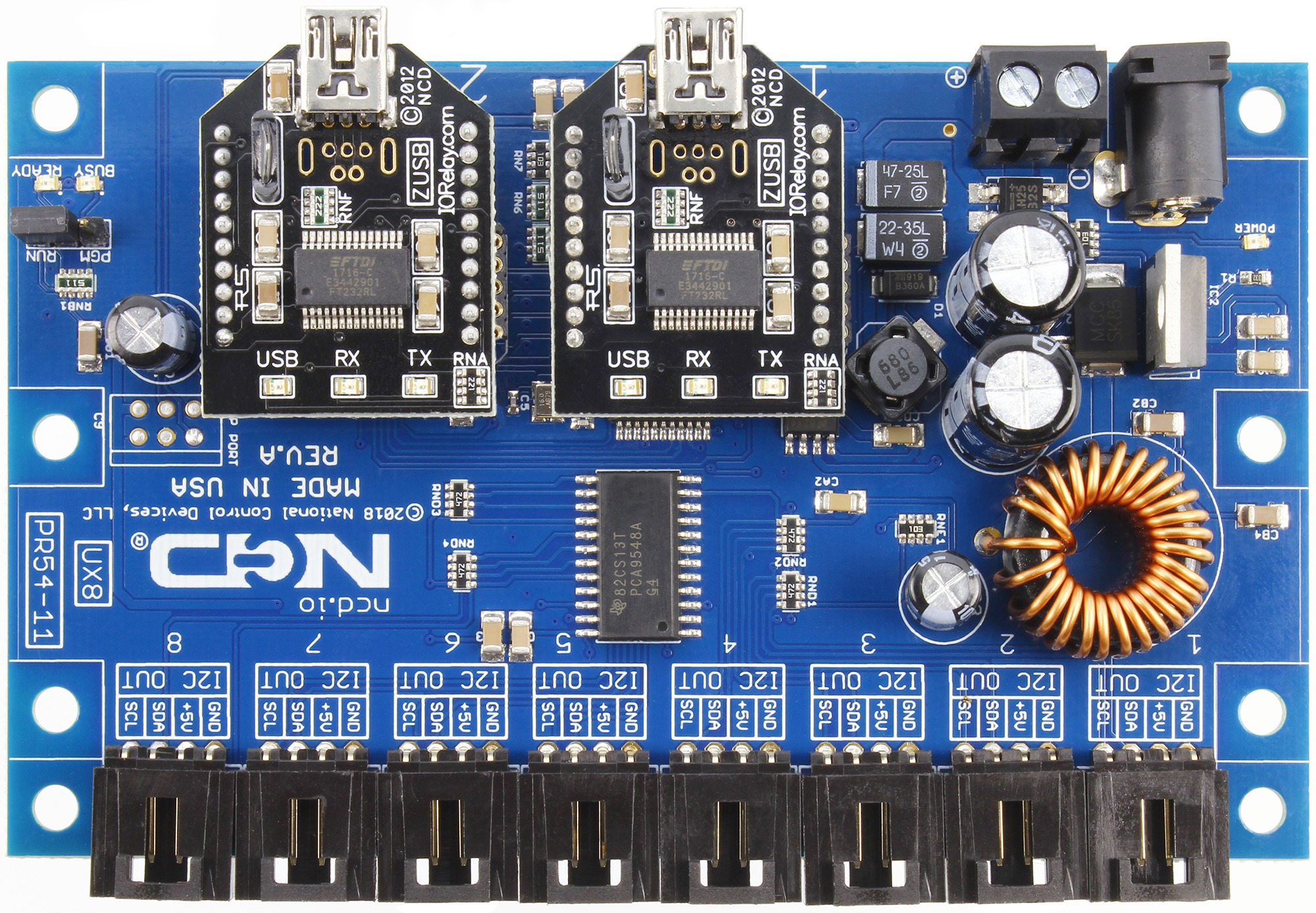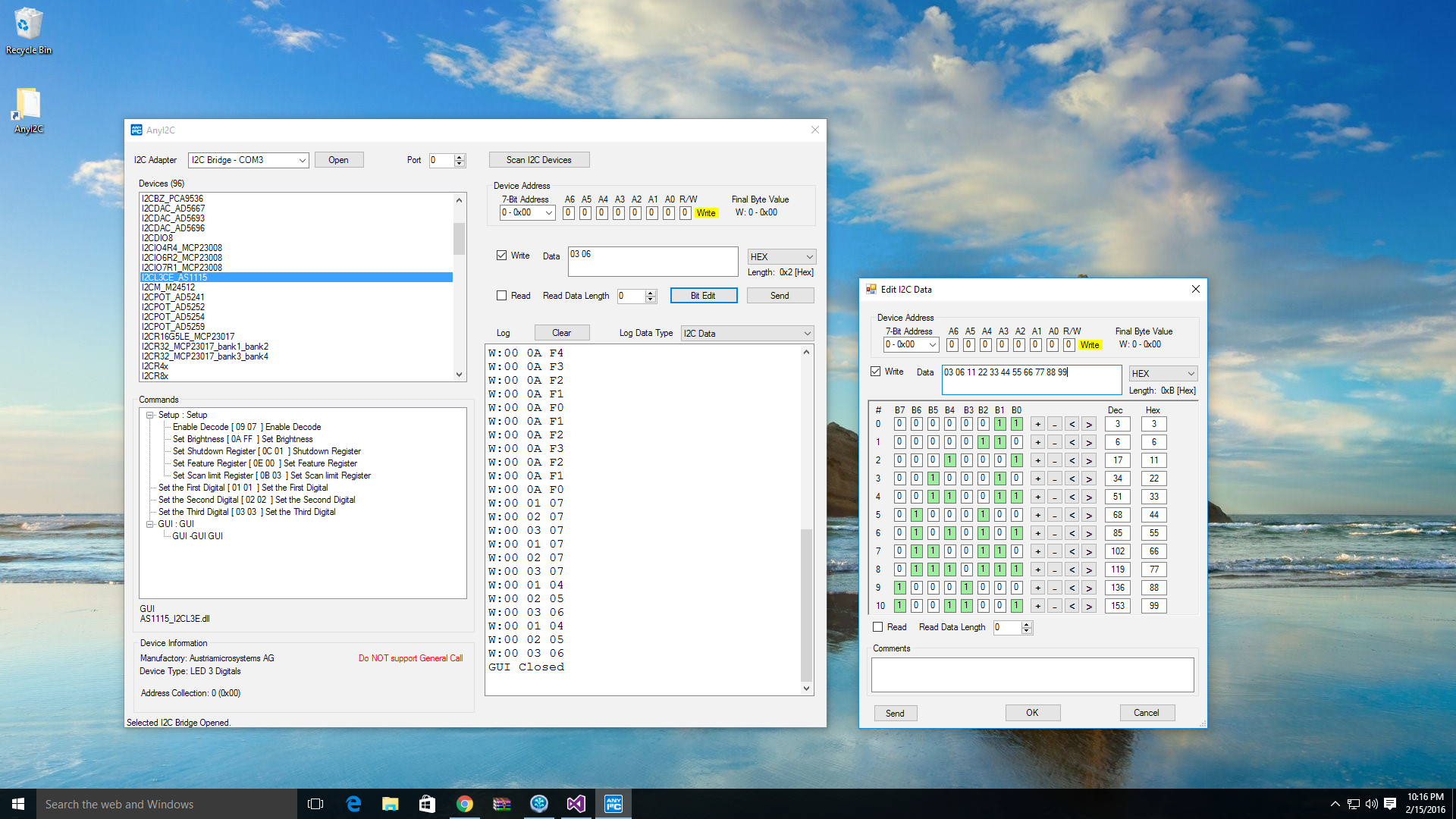I2C Converter with Dual Serial to 8-Port Hardware I2C
Highlights
- 8-Port Master Hardware I2C Converter
- Dual Communications Interface Ports
- Choice of Two Communication Modules
- Communicates with Two PCs Simultaneously
- Supports Many Communication Expansion Options Including:
- Ethernet, WiFi TCP/IP, and WiFi MQTT
- Bluetooth, RS-485, RS-232, and Long Range Wireless
- Eight 5V nodeLynk I2C Communication Ports
- 2-Amp Power Supply Shared Among All 8 nodeLynk I2C Ports
- I2C Bus Scanning, I2C Write, and I2C Read Commands
- I2C Port Switching and I2C Write Read Commands
- Test, Control, and Learn I2C Communications
- Connect Sensors for Monitoring Applications
- Control Relays, Pumps, Lights, and More
- Long-Range Wireless I2C Upgrade Option
- Integrated ProXR Enterprise Command Set
The Ultimate Serial to I2C Converter Adapter
Introducing the world’s most powerful and expandable Serial to I2C Converter. With Eight nodeLynk I2C Expansion Ports and Two Interchangeable Communications Ports compatible with Digi XBee®, this powerful I2C adapter offers the highest possible conversion speed with the most efficient command set available. Communications modules may be interchanged for your choice of communication requirements. Based on the endNode architecture, this controller provides an excellent platform to help simplify communications to otherwise complex I2C devices. Over a year in development, this device served as the development platform for our endNodes architecture, which includes an incredible command set for relay control, far beyond I2C conversion. New features include hardware I2C communications now supporting speeds up to 700KHz. Set the communications speed of each nodeLynk I2C Port as part of Device Configuration. This device now includes a new command set that simplifies read and write operations to I2C devices. New I2C Bus Scan functions scans and reports all detected devices on each I2C port in less than 1 Second.
An I2C Converter with Brains: endNode Architecture & ProXR Enterprise
We’ve also added ProXR Enterprise to the command set, which is our most powerful relay control command set to date. Capable of controlling up to 1,024 relays using 8 nodeLynk I2C ports, this is our most expandable relay controller we have ever manufactured. Designed to work with all MCP23008 and MCP23017 I2C Relay Controllers, ProXR Enterprise adds powerful commands for turning relays on or off, toggling the state of relays, pulsing relays, and controlling relays in groups. ProXR Enterprise also offers powerful relay timer capabilities to activate relays for a duration of time or to trigger different commands when timers finish their counting cycle. Integrated Macros make it possible to send a simple command to execute a list of up to eight commands in the background. Powerful startup functions allow you to execute commands when power is first applied to the controller in addition to complete power-up relay state control. Integrated Non-Volatile FRAM memory allows unlimited read/write capabilities without memory degradation and no battery backup required. FRAM memory keeps track of relay status, timers, macros, and many important system settings. New Relay Counters control relays in patterns using Counter Increase and Decrease functions. Relay Counters can be used for efficient lighting control, emergency lighting, or signage applications. Automatic and Manual Relay Refresh Modes allow you to send relay control commands without affecting relays. When you ready, simply send a refresh command and refresh every relay connected to the controller.
The Best I2C Converter with Eight Hardware nodeLynk I2C Ports
With 8 on-board nodeLynk I2C Ports and up to 2 Amps Shared Among All Ports, the converter offers a powerhouse of expansion options. Connect Relays, GPIO, Gas Sensors, Temperature Humidity Sensors, Thermocouples, and 4-20mA current loop input output controllers. Expand anytime to include voltage detection, current monitoring, programmable FET control, pulse width modulation, and much more. The dual port adapter offers more expansion and compatibility than previous generation controllers. As a serial to I2C adapter, this device is future proof and ready to talk to the next generation of sensors and controllers without the need for firmware updates. Simply update your software to talk to the latest generation of I2C devices.
I2C Converter with Two Digi XBee® Compatible Communications Ports for Wireless Communications
New Wireless Protocols for Long Range Wireless Communications up to 2 Miles are now supported in native API communications structure. Send commands to this nodeLynk I2C converter from a wireless modem and command responses will be sent back to the modem. This nodeLynk I2C converter supports the use of multiple wireless modems, as all responses are coded to return to the origin. Supports Select Digi 900MHz, 868MHz, and 2.4GHz Communications Options for worldwide compatibility with the best possible range legally allowed.
USB to I2C Conversion
Convert USB to I2C by loading a USB interface into a communications socket. The USB communications module will mount as a Virtual COM Port on your PC for communications using simple serial commands at 115.2K Baud.
RS-232 to I2C Conversion
Convert RS-232 to I2C by loading a RS-232 interface into a communications socket. This nodeLynk I2C converter will convert RS-232 to I2C, allowing the use of simple serial commands at 115.2K Baud. Connect to desktop computers or embedded systems to greatly simplify communications to I2C devices.
RS-485 to I2C Conversion
Convert RS-485 to I2C by loading a RS-485 interface into a communications socket. This nodeLynk I2C converter will convert RS-485 to I2C, allowing the use of simple serial communications to talk to a multi-drop RS-485 network of I2C Converters.
Bluetooth to I2C Conversion
Bluetooth to I2C Conversion requires the use of the WiFi option during checkout, users may choose to use the WiFi, Bluetooth, or USB communications technologies by using a single WiFi module that integrates all three technologies into a single communications module.
Ethernet and WiFi to I2C Conversion
Network communications could not be any easier. Simply associate this device with your network using WiFi (2.4GHz Only) or a Ethernet cable connected directly to your router, open TCP socket 2101 and start sending and receiving TCP data. Both Ethernet and WiFi options support DHCP, Programmable TCP Port, and a Programmable Static IP address. Both communication options also support web page configuration of communication technologies. The WiFi Option Supports WiFi TCP/IP and WiFi MQTT Communications.
MQTT Over WiFi
Our nodeLynk I2C Converter becomes a internet controlled device when using the WiFi option. Paired with our new WiFi communications module, the MQTT communications option may be used, allowing this device to talk directly to MQTT servers using a single publish and subscribe topic used for transporting low-level I2C messages. This effectively allows any command to be executed via MQTT communications for remote operation from anywhere in the world.
I2C Converter Re-Engineered
This device acts has a hardware dual port serial to master hardware I2C protocol converter designed to communication with NCD nodeLynk I2C node devices. I2C Master controllers initiate communications to node devices such as ADC, DACs, Potentiometers, PWM controllers, GPIO controllers, and a wide variety of sensors. I2C node devices are always speak when spoken to, they do NOT initiate communications with a master I2C controller. Conversion works by sending a single hardware I2C port selection along with a I2C start address as well as any associated parameters, as well the number of bytes you would like to request from the I2C device. The I2C converter will exchange all data and report the response from the I2C device via a serial format. The term “hardware” is used to indicate that dedicated hardware is used for all serial and I2C communications. This device does NOT use a virtual serial ports or I2C ports which would greatly limit communications speed. Instead, this device uses dedicated hardware peripherals for all communications to greatly enhance speed and reliability of communications. The term “master” is used to indicate this device will initiate communications with a node. It is not possible for a node to initiate communications with a master, as this is not supported in the I2C protocol.
This device now includes more powerful commands that execute faster than previous generation controllers including I2C Bus Scan, used to displays all devices connected to a nodeLynk I2C port. New I2C converter commands for I2C Write, I2C Read, and I2C Write/Read operations, which are now executed using hardware I2C ports rather than software emulated ports found in previous generation controllers. The new hardware I2C ports offer I2C Bus Speeds up to 700KHz per nodeLynk I2C Port. I2C Port Switching and Communications is now executed as a single command, offering incredible speed for switching ports and executing read/write operations with a single transaction.
New I2C Software for Windows
- Designed to work with AnyI2C for learning I2C Communications. Of course we had to support AnyI2C, but we’ve made some updates to improve speed and compatibility with this device.
- Designed to work with Alpha Station for Advanced Features. Use Alpha Station to explore our new ProXR Enterprise command set or develop your own Visual Studio code using our libraries.
- Be sure to check out the Resources section of our web site, endNode devices are heavily documented with tons of helpful information.
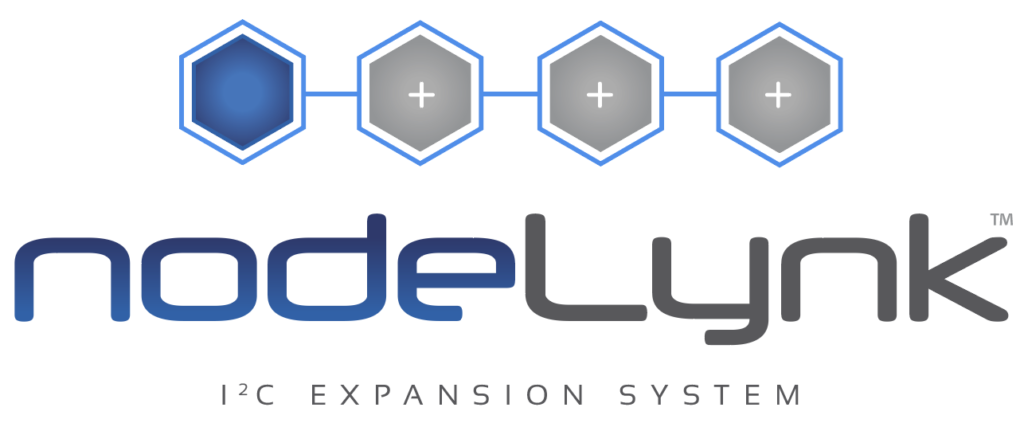
nodeLynk™ Master Adapter
This is a nodeLynk Master adapter. nodeLynk Master adapters speak to a chain of nodeLynk devices using I2C communications.
What is nodeLynk?
Chain expansion devices using nodeLynk. Connect a wide variety of accessories to expand the capabilities of a nodeLynk compatible controller. Use nodeLynk to add Relay Controllers, Sensors, PWM Drivers, Displays, and a wide variety of 4-20mA, 0-10V ADCs and DACs, as well as a wide array of TTL & Isolated GPIO devices. All nodeLynk devices use I2C communications to chain devices together. nodeLynk is an easy way to expand functionality without soldering. nodeLynk allows expansion in seconds so you can focus on your software and firmware development.

Designed with Visual Studio in Mind
The NCD WiFi to I2C Converter is a perfect companion to add automation, sensing, monitoring, and control features to Visual Studio applications. We are always improving our Alpha Station Software framework, which includes all libraries needed to communicate to every kind of I2C sensor and controller imaginable. Simple libraries for I2C Read, Write, and Write Read operations make it easy to talk to all kinds of hardware with minimal time investment. Talk to displays, sensors, multiplexers, relay controllers, pulse width modulators, and more. The Alpha Station framework is ready to go to work monitoring and controlling using Visual Studio Community Edition (free from Microsoft.com).
Control LCD Displays with Visual Studio
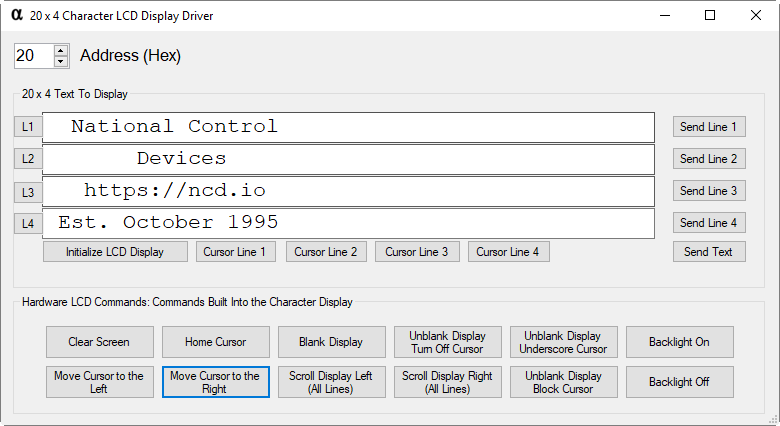

Alpha Station provides you with a working sample framework, take a look at the source code to see how easy it is to control this display:

Read MAX1069 Analog to Digital Converters with Visual Studio
Alpha Station gives you the tools you need to quickly read and display Analog to Digital Values such as the MAX1069 connected to a 8-Channel Multiplexer to display the result. Reading and Displaying ADC Values could not get any easier. Notice how we use the I2C Write Read Command to talk to the MAX1069 with a start address of &H37, this command handles all the low-level I2C communications to the chip, you simply specify the start address, number of bytes you would like to read (2), and the delay (0) between the Write and Read operation. When the chip returns a response, it should be 2 bytes in Length. The response is then converted to a 14-Bit value using the NCDLib.Math.MSLBLS14 command. The value can then be displayed directly to the console.
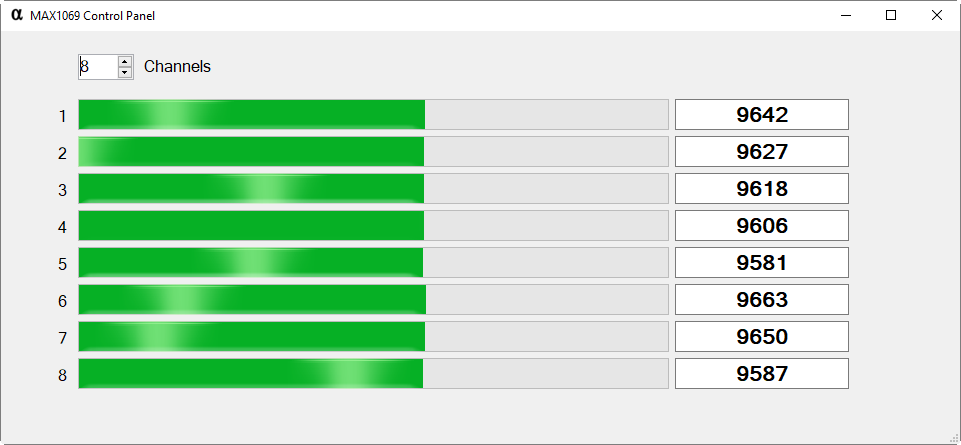
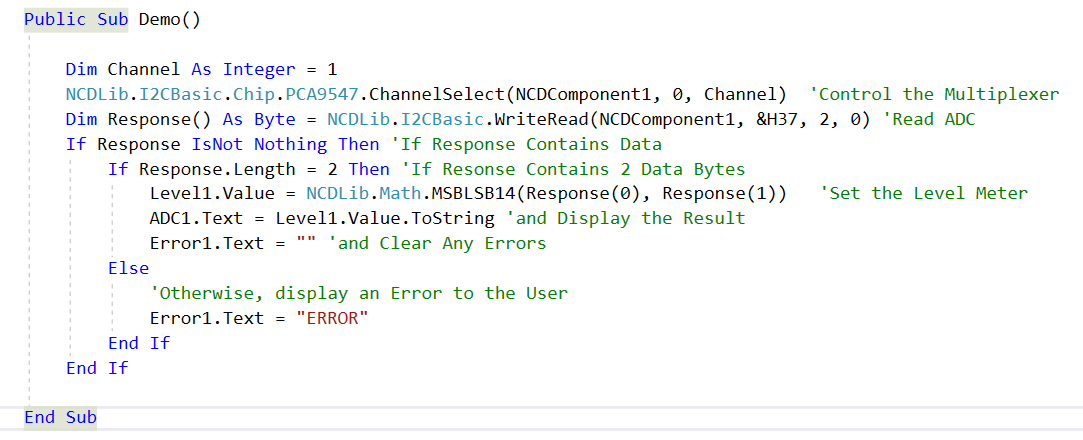
Control a AS1115 LED Display with Visual Studio
Alpha Station Libraries make it easy to control hardware. The AS1115 Library is used to communicate numeric values directly to a LED display. Values from 0 to 999 are supported as well as brightness levels of 0 to 15. Simple library calls are all it takes to setup a dedicated hardware numeric display.
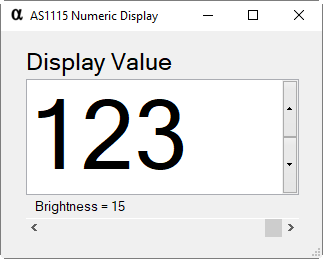
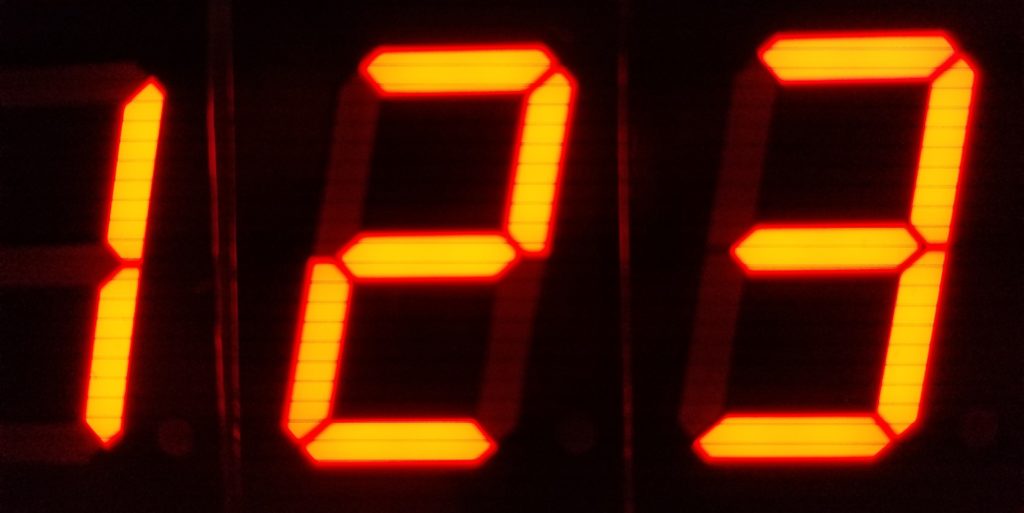
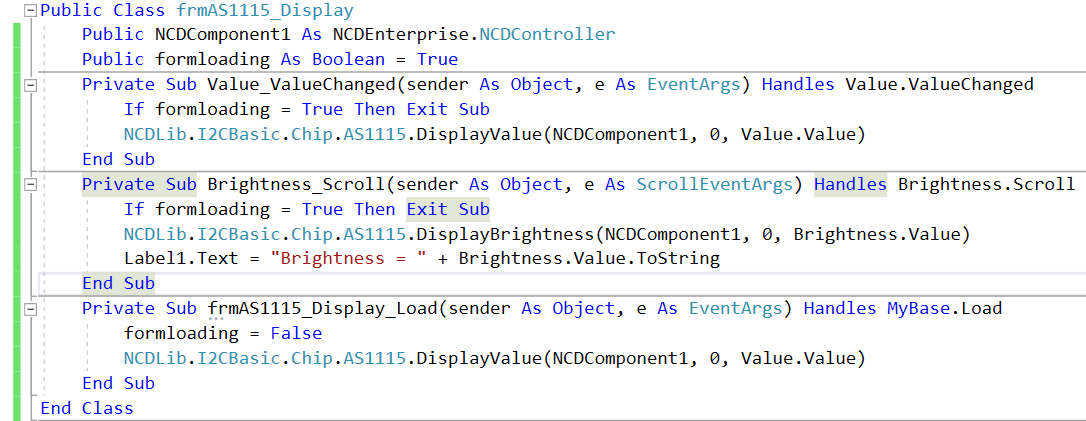
XBee® is a registered trademark of Digi International. www.digi.com

nodeLynk™ Device
This is a nodeLynk device, it will require a nodeLynk Master Adapter for proper operation. nodeLynk devices plug into Master microprocessors to easily add hardware sensing and control capabilities.
What is nodeLynk?
Chain expansion devices using nodeLynk. Connect a wide variety of accessories to expand the capabilities of a nodeLynk compatible controller. Use nodeLynk to add Relay Controllers, Sensors, PWM Drivers, Displays, and a wide variety of 4-20mA, 0-10V ADCs and DACs, as well as a wide array of TTL & Isolated GPIO devices. All nodeLynk devices use I2C communications to chain devices together. nodeLynk is an easy way to expand functionality without soldering. nodeLynk allows expansion in seconds so you can focus on your software and firmware development.

What is the nodeLynk I2C Interface?
NCD is the creator of plug and play modular hardware using nodeLynk, which is hardware I2C Interface connector standard. nodeLynk I2C devices allow you to chain together several devices on the I2C bus, and communicate to each device individually at high speed (subject to the limitations of I2C). The nodeLynk I2C Interface uses a standard 4-Pin I2C Input and I2C Output connector. nodeLynk I2C devices communicate 5V I2C data and provides 5V DC power through this connector. nodeLynk I2C devices use standard I2C communications for all data transport, which is supported by nearly every microcontroller in production today. The nodeLynk I2C Interface is strictly a 5V standard, which is ideal for transport across longer cables. nodeLynk I2C devices always include a 6″ (152mm) 4-conductor I2C cable. nodeLynk I2C Mini Modules always include a 3″ (76mm) 4-conductor I2C cable. Cables and connectors are available separately for designers who would like to include their own nodeLynk I2C Interface into their designs.
Plug and Play Connectivity
nodeLynk I2C devices will plug in to any available nodeLynk I2C Output. This includes just about everything we make in the NCD IoT Category, including all NCD IoT devices. We also manufacture a wide range of I2C adapters that make it easy to plug nodeLynk I2C Devices directly into most computing platforms. nodeLynk I2C Interface adapters are available for Arduino, Banana Pi, BeagleBone, Bluz, ESP8266, Onion Omega, Particle Photon and Electron, PyCom, Raspberry Pi, 2, 3, and Zero, and Windows. We are always working to add new platform support for nodeLynk I2C devices. nodeLynk I2C Interface devices are compatible with just about everything in the microcontroller industry.
Unlimited I2C Expansion
Based on our plug-and-play I2C interface standard, all nodeLynk I2C devices are equipped with a I2C output port, making it easy to expand to a wide variety of sensors, current monitors, relay controllers, PWM controllers, and much more! We are always designing new expansions for our modular plug-and-play I2C framework. We are dedicated to building a product line of interconnected devices to simplify all forms of automation. Re-use or upgrade your hardware in seconds by selecting the modules that best fit your needs, and chaining them together using the included I2C expansion cables!

A Raspberry Pi (above) is connected to a nodeLynk Master adapter. nodeLynk devices are chained to the Raspberry Pi nodeLynk Master using I2C communications. Each nodeLynk device must have a different I2C address for proper operation of the chain. Note that some nodeLynk I2C devices have a fixed address while others allow configuration of the address across a limited range of addresses.
Powering nodeLynk I2C Interface Devices
Some nodeLynk I2C devices require a external power supply, others may be powered through the 4-Pin I2C bus connector at 5VDC, and other devices are jumper selectable between external and I2C bus power. All I2C mini modules are powered through the 5V I2C bus connector, greatly simplifying connectivity.
Mechanical Drawing

Wiring Diagrams
Documentation Downloads
- API Calculator for Generating USB and Wireless Commands
- Properly Encodes Commands for Wireless and USB Communications
- endNode Command Set
- Basic Requires and Communications Protocol
- Wireless I2C communications
- ProXR Enterprise Command Set
- endNode Device Configuration
- Configure Device Communications Speed
- Configure Region and Wireless Options
- Configure ProXR Driver Options
- Configure I2C Bus Speeds
- endNode Memory Map
- Examine endNode FRAM Memory
- Read and Write Directly to endNode FRAM Memory
- Alpha Station Software for Setup, Testing, and Learning
- Required Software for Learning and Configuring the UX8
- Also Compatible with AnyI2C Software for I2C Communications
900HP-S3B Wireless Compatibility Notes
Notice: Compatibility Notes Does NOT Apply to the Following Products:
- NCD Enterprise Solutions
- NCD Wireless Sensors
- NCD Enterprise Modems and Gateways
Notice: Compatibility Notes Applies to NCD Industrial Products, Including Fusion, ProXR, ProXR Lite, Taralist, and Reactor Series Products.
Compatibility Notes
When using an 900HP-S3B communication module, it is essential that you use the ZIGMO_PCB to configure the module settings. Long-Range wireless sensors may be programmed over the air without removing the communications module.
A 900HP-S3B Modem or a gateway of some kind that support the 900HP-S3B communications module will also be required.
Ethernet TCP/IP Compatibility Notes
This device periodically sends UDP Packets on port 13,000, which help identify the IP address of this device on your network.
I2C Interface Compatibility
NCD I2C Interface devices are designed to plug in to many popular IoT computing platforms. This allows the “brains” from other manufacturers to directly plug into our devices for easy plug-and-play operation. I2C interface devices use I²C as the underlying communications technology. The notes below will guide you into plugging 3rd party technologies into our devices, we will highlight any adapters that may be required in this section. Please note that all NCD I2C Interface Devices can be chained together to any other Cross-Platform I²C Slave Devices using the I²C Output. Additionally, NCD I2C devices may be plugged into the I2C Output of NCD IoT Interface devices. A complete list NCD I2C Interface adapters is available by clicking here.
Arduino Interface
- Plug this device into the Arduino Micro I2C Shield
- Plug this device into the Arduino Nano I2C Shield
- Plug this device into the Arduino Uno I2C Shield
- Plug this device into the Arduino Due I2C Shield
Banana Pi Interface
- Plug this device into the Banana Pi I2C Shield
BeagleBone Interface
- Plug this device into a BeagleBone I2C Shield
Bluz Bluetooth Interface
- Plug this device into the Bluz I2C Shield (with power)
C.H.I.P. Interface
- Plug this device into the C.H.I.P. I2C Shield
ESP8266 Interface
- Plug this device into the NodeMCU ESP8266 I2C Shield
- Plug this device into the Adafruit Huzzah ESP8266 I2C Shield
Particle Interface
- Plug this device into a Particle Photon WiFi I2C Shield
- Plug this device into a Particle Electron Cellular I2C Shield
Onion Omega 1 & 2 Interface
- Plug this device into a Onion Omega I2C Shield
PyCom Interface
- Plug this device into a PyCom WiPy, WiPy2, and LoPy I2C Shield
Raspberry Pi Interface
- Plug this device into a Raspberry Pi I²C Interface Adapter
- Plug this device into a Raspberry Pi 2/3 I²C Interface Adapter
- Plug this device into a Raspberry Pi Zero I²C Interface Adapter
Windows 8/10 PC USB Interface
- Plug this device into a USB to I2C Converter
- Plug this device into the BridgeX5 Series Controller
RS-232 Serial Compatibility Notes
The NCD RS-232 Serial communications module is compatible with standard RS-232 signals (+/-10VDC), which are not directly compatible with UART signals from a microprocessor. If you are working with Arduino, Microchip PIC, or other common microcontroller, a communications module is not required. Microcontrollers will directly talk to the on-board processor of all NCD controllers.
RS-485 Serial Compatibility Notes
The NCD RS-485 Serial communications module is compatible with NCD ProXR, ProXR Lite, Fusion, and Taralist series controllers. This module was designed to work with NCD devices, but may be used with devices outside the NCD family. This device acts as a transparent RS-485 to USART serial converter. Non-NCD products will require a software networking protocol to support multiple devices.
Out of stock

